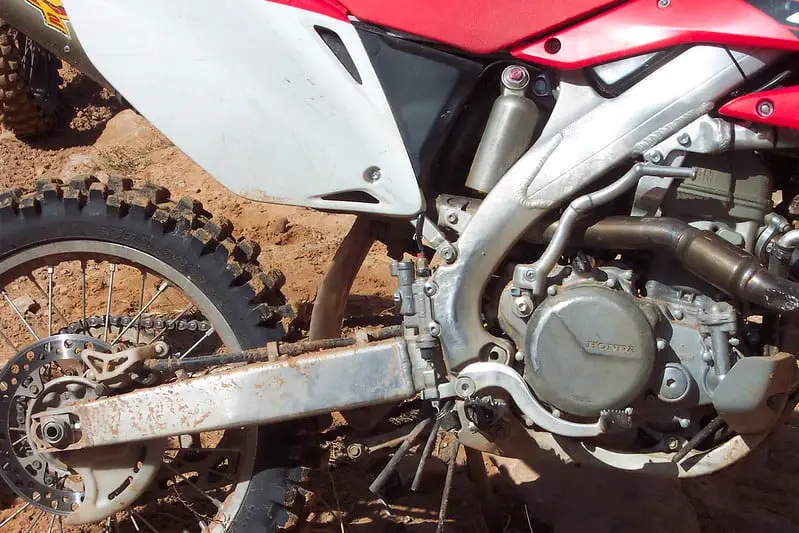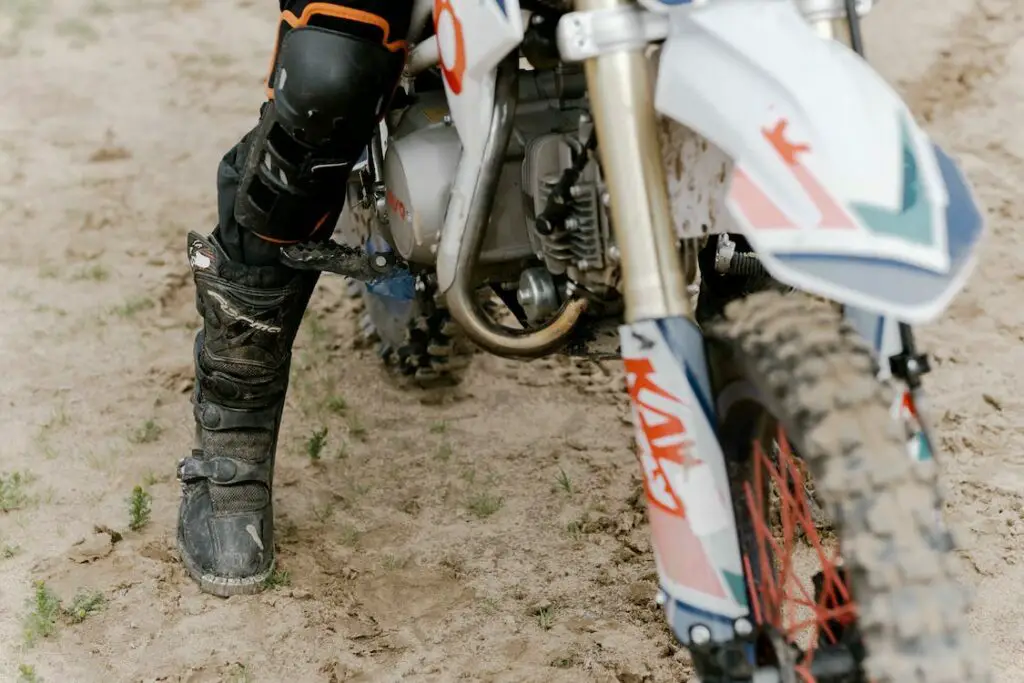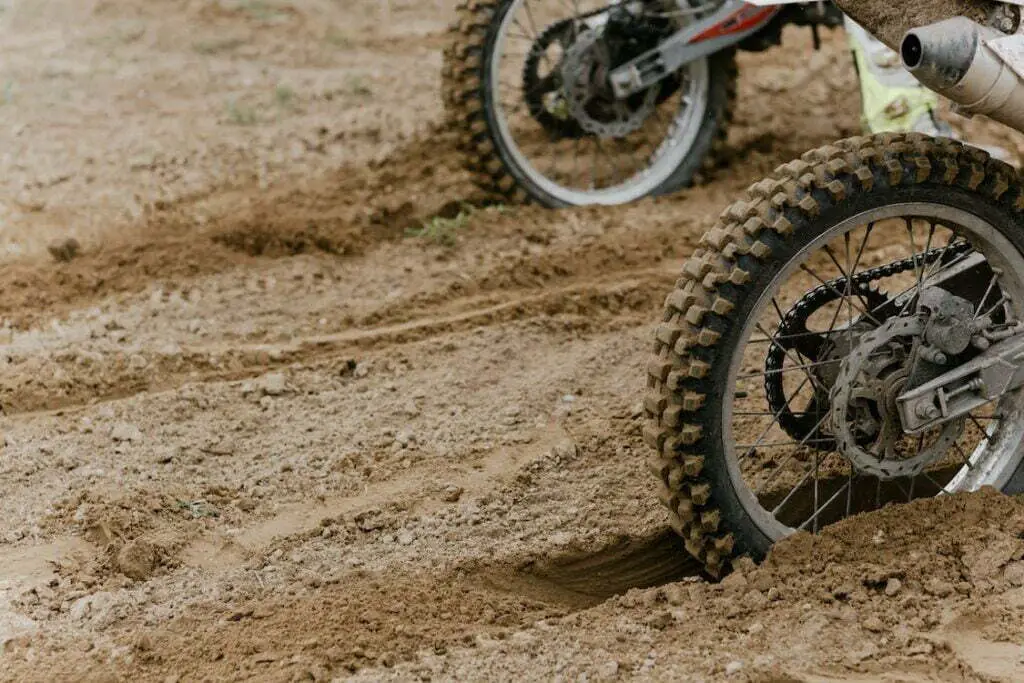Riding a dirt bike can be an exhilarating experience, but it can quickly turn into a nightmare when your dirt bike won’t start.
One of the most common issues is the engine’s inability to start due to a lack of spark.
This problem can be caused by various factors that range from simple to complex.
Together we’ll explore what causes no spark to spark plug in dirt bikes and what steps you can take to troubleshoot and fix the problem.
So, if you’re facing this frustrating issue with your dirt bike, keep reading!
No spark in a dirt bike can be caused by a faulty spark plug, bad ignition coil, wiring issues, a faulty kill switch, or a failed stator or CDI. Proper diagnosis is important, and repairs should be done by a qualified mechanic if you’re not familiar with dirt bike mechanics.
The importance of spark plugs in dirt bikes
The spark plug is a critical component of a dirt bike’s engine.
It plays a crucial role in igniting the air and fuel mixture in the combustion chamber, which is necessary for the engine to start and run.
Without a functioning spark plug, the engine won’t be able to produce the power needed for the bike to move.
A faulty spark plug can cause a variety of problems, including reduced power, misfires, and even engine damage.
Regularly checking and replacing the spark plug is essential for maintaining the performance and longevity of the dirt bike’s engine.
It’s important to use the correct type of spark plug (one that’s recommended by the manufacturer) to ensure optimal performance and prevent potential damage to the engine.
Before diving into the causes of no spark let’s briefly touch on the ignition system.
Understanding the ignition system in dirt bikes
The ignition system is responsible for providing the high voltage needed to create the spark inside the spark plug, which ignites the air-fuel mixture in the engine’s combustion chamber.
The ignition system consists of several components, including the battery, ignition coil, stator or CDI, and wiring system.
When you push the start switch (on electric start dirt bikes), the battery provides power to the ignition coil and converts it into a high voltage current to create a spark.
Any malfunction in this system, such as a bad ignition coil or faulty wiring, can hinder the spark plug’s performance and lead to weak or no spark.
That’s why it’s important to regularly inspect and maintain all components of your dirt bike’s ignition system to ensure optimal performance.
Causes and symptoms of weak or no spark in dirt bikes
Now that you understand the importance of spark plugs and the ignition system, let’s explore the causes and symptoms of weak or no spark in your dirt bike.
Weak or orange spark can be an indication of a coil that is not generating enough voltage, while no spark at all could mean a broken wire or a failed CDI unit.
Moisture in the circuit or dirt and corrosion in the wiring harness can also cause intermittent spark.
Another culprit could be a dirty or worn spark plug, or a damaged spark plug wire.
If you’re experiencing any of these symptoms, it’s time to start troubleshooting.
Check the condition of your carburetor, inspect the ignition switch, and test your stator and CDI unit.
If any part of your ignition system is dirty, be sure to clean it with contact cleaner.
Remember, a weak or no spark in your dirt bike could prevent it from starting, so it’s important to address these issues as soon as possible.
Overheating as a primary cause of spark plug failure
One of the primary reasons spark plugs can fail is due to your dirt bike overheating.
Overheating can be caused by pre-ignition or a malfunctioning cooling system, and it can lead to premature spark plug failure.
As we’ve discussed, when a spark plug overheats, it can cause the electrode to wear out quickly, leading to weak or no spark.
This means that your dirt bike may struggle to start or might not start at all.
It’s essential to be mindful of your dirt bike’s temperature and to ensure that your cooling system is functioning correctly.
Overheating can cause a host of problems, including damage to your engine and, as we’ve discussed, premature spark plug failure.
So, regularly checking your spark plugs for signs of wear or overheating can help you catch any potential issues before they become severe.
Along with monitoring your dirt bike’s temperature, it’s also crucial to understand the impact of the spark plug’s temperature range.
If you’re using a spark plug with the wrong heat range, it can overheat, leading to premature failure.
So, always check your owner’s manual for the correct spark plug temperature range for your dirt bike.
So, keep an eye out for signs of overheating or wear, and regularly check your spark plugs to ensure your dirt bike is running at its best.
Improper spark plug temperature range and its impact on igniting fuel mixture
Sometimes, spark plugs fail to ignite the air-fuel mixture, leading to weak or no spark in dirt bikes.
One of the primary causes of such a failure is an improper spark plug temperature range, meaning the heat rating of the spark plug is incorrect.
If the spark plug gets too hot, it may cause “pre-ignition,” which leads to inefficient fuel combustion.
On the other hand, if the spark plug is too cold, it cannot burn off the carbon deposits, which could lead to fouling.
This improper temperature range affects the spark plug’s ability to ignite the air-fuel mixture, leading to poor engine performance.
Therefore, it is crucial to select the correct spark plug heat range to ensure optimal spark plug performance and efficient combustion of the fuel mixture.
How conductive carbon deposits lead to energy leakage and weaken spray sparks
Carbon deposits are conductive and can create energy leakage, which weakens the spray sparks.
This is a common issue in dirt bikes that have a rich air-fuel mixture, weak ignition, or the wrong heat range for the spark plugs.
To prevent carbon fouling, make sure to maintain your ignition system properly and replace spark plugs when necessary.
Remember, a clean spark plug is vital for proper ignition and combustion.
If you notice carbon deposits on your spark plug, use a plug cleaner to remove them.
This will help to ensure your dirt bike is running efficiently and that your spark plugs are sparking strong.
How to diagnose and fix no spark in dirt bike

Perfect, now that we’ve covered some theory and you have more background knowledge, let’s dive into what you actually came here for – the solutions.
Below I’ve listed a number of things to check if your bike isn’t starting. Most of these you can do yourself at home.
Faulty spark plug in dirt bike
As we discussed earlier, spark plugs are crucial components in igniting the fuel mixture in your engine.
A spark plug that is worn out or damaged will not produce a spark.
Over time, deposits from fuel and oil can build up on the electrode, inhibiting its ability to create a spark.
Symptoms of a bad spark plug can include difficulty starting your bike, poor performance, and increased fuel consumption.
If you suspect your spark plug is faulty, it’s relatively easy to check and replace.
Removing the spark plug and checking for signs of wear or damage can help diagnose the problem.
Don’t overlook this simple fix when troubleshooting a no spark issue in your dirt bike.
Here’s a handy video showing how to take out and clean a motorcycle spark plug.
Bad ignition coil in dirt bike
Ignition coils play an essential role in generating the high voltage needed to create a spark in the spark plugs.
Without a properly functioning ignition coil, the spark plugs won’t ignite the fuel mixture, causing your dirt bike to fail to start.
As we previously discussed, there are several causes of weak or no spark, including faulty spark plugs, wiring issues, and failed CDI or stator.
But if you’ve ruled out those issues, it’s time to check the ignition coil.
A faulty ignition coil can lead to inconsistent sparking or total loss of spark, resulting in engine failure.
Fortunately, this is a relatively easy fix, and replacing the ignition coil should get your dirt bike up and running again in no time.
Wiring issues in dirt bike
A faulty wire can cause a short to ground, which will prevent your spark plug from receiving the necessary current.
It’s important to check all of the wires connecting the various components of your ignition system to ensure they’re properly connected and not damaged.
Remember, it’s not just about getting power to your spark plug, but also getting the right amount of power at the right time.
Wiring issues can disrupt that process, leading to frustrating starting problems.
Check the wiring to make sure all connections are secure and there are no breaks or damage to the wires.
Faulty kill switch in dirt bike
If you’ve ruled out shorts, grounds, switches, and spark plugs, it’s time to inspect and diagnose the kill switch.
The kill switch’s purpose is to cut power to the ignition system and prevent the engine from running in case of an emergency.
However, if the switch is faulty or worn out, it could interrupt the spark’s flow and cause a no-start condition.
Therefore, it’s essential to check the continuity of wires leading to the kill switch, as well as the switch itself.
Test the kill switch to see if it is functioning properly and replace it if necessary.
Failed stator or CDI in dirt bike
Another pretty common culprit is a failed stator or CDI.
While it can be difficult to diagnose these issues, they can cause a range of problems with the ignition system that ultimately prevent your spark plug from firing.
If you’ve ruled out other issues, such as faulty spark plugs or wiring problems, then it may be time to turn your attention to these components.
Keep in mind that a deteriorating stator or CDI can be caused by a variety of factors, including wear-and-tear and exposure to moisture.
Fortunately, a skilled mechanic can often repair or replace these components to get your dirt bike up and running once again.
Factors that stress an engine and weaken spark plug performance
Now that you understand the crucial function of spark plugs in dirt bikes and the causes of weak or no spark, let’s explore the factors that can cause stress on your engine and reduce spark plug performance.
The quality of fuel and oil you use in your engine can have a significant impact on your spark plug performance.
Using lower quality fuel with a higher concentration of impurities like sulfur, can lead to fouling and carbon deposit build-up on spark plugs, reducing their effectiveness.
Excessive heat generated in the engine due to high RPM, towing heavy loads or climbing steep hills can also stress your engine, leading to misfires and weakened spark plug performance.
Additionally, improper air-fuel mixture or incorrect ignition timing can cause fuel to burn at higher temperatures, leading to pre-ignition and detonation, both of which can cause damage to your spark plugs.
By paying attention to the factors that stress your engine and taking proper precautions, you can reduce wear-and-tear on your spark plugs, improving their longevity and efficiency.
Wrapping up
When it comes to gasoline engines, spark plugs play an absolutely crucial role in ensuring smooth operation and peak performance.
The spark plug is responsible for igniting the fuel mixture in the cylinder, which in turn powers the engine.
Without a properly functioning spark plug, your dirt bike isn’t going anywhere fast (if it’s going anywhere at all).
That’s why it’s so important to keep your spark plug in good condition and make sure it’s properly gapped and installed.
But it’s not just about the spark plug itself – there are a ton of factors that can impact spark plug performance, from engine defects to fuel quality to overheating.
By staying on top of these issues and addressing them promptly, you can help ensure that your spark plugs (and your dirt bike) keep running strong for years to come.



